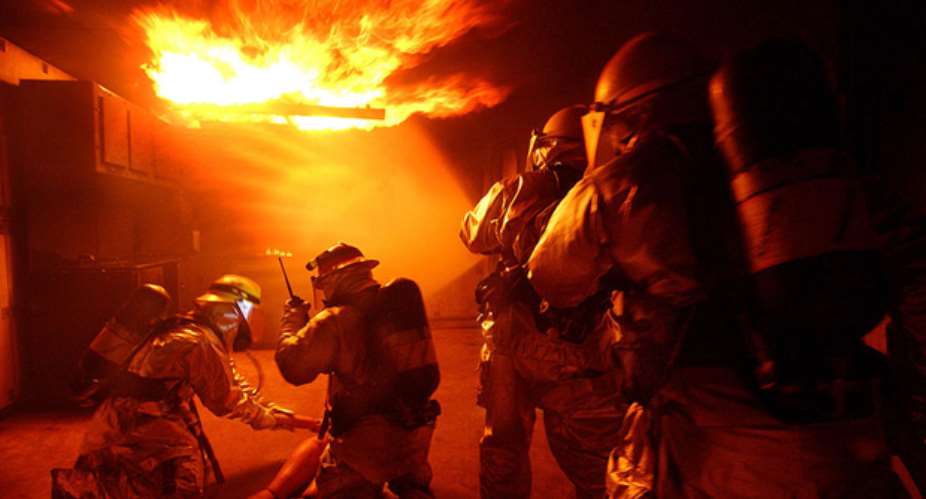The fire which gutted the Central Furniture Works at Sakaman in Accra last Friday was heartbreaking, considering the investment which was completely destroyed.
At the time of the fire, freshly cleared imports from the port were stored on one of the floors. These were reduced to ashes and unintended charcoal.
What firefighters succeeded in doing was stopping the fire from spreading to nearby facilities such as a fuel station. As for the much stuff in one of the country's largest furniture companies, they could not be salvaged.
In yesterday's edition of this paper, the Managing Director of the company, Mustapha Mahama, disputed the remark by the Ag Head of Public Relations of the Ghana National Fire Service (GNFS) after he said 95 per cent of materials at the fire scene were salvaged. It is appropriate to rather state that close to that figure of materials were torched and destroyed.
It is good for the spokesperson of the GNFS to present his organization in good light. After all, that is what he is supposed to do. Not so, however, when the truth is glaring and cannot be swept under the carpet as he sought to do.
With fifty or so workers automatically redundant and all pieces of equipment destroyed, including finished works awaiting delivery to their final destinations, presenting a glossy picture can be irritating especially to the owners of the company.
While it took a long time for a fire tender to respond to the distress call when the fire started, the water was soon exhausted as we learnt from the company. The exploding lacquer and other chemical ingredients in the industry were, of course, not responding to the water being used to fight them.
The appropriate apparel for venturing into the eye of the fire was also not available for most of the time.
By the time the appropriate and effective response came, the fire had already destroyed most of the items within the premises to ruins. That was the story of the managing director.
We do not doubt the competence of our firefighters to contain fires; we cannot do same for the quality and quantity of materials required for fighting the various classes of fire.
The frequency of fire tenders going to fire scenes and running short of water is all too common in our communities. There are inherent challenges which must be addressed because the place of firefighting and managing other disasters in every civilized society cannot be overlooked.
Firefighting is not restricted to putting out fires but goes beyond that. It is for this reason that the necessary tools firefighters require to manage disasters successfully have to be provided to the GNFS.
For instance, we have learnt how the initial firefighting squad which responded to the distress call at the furniture workshop could not do much because they did not only lack the necessary apparel they also did not have oxygen bottles and masks. By the time a team primed with these arrived to join the fight, fire had destroyed most of the contents of the furniture company.
Firefighters are not supermen and so need to fight fires when they are properly tooled and primed for the tasks.
As a matter of urgency, we are calling on city managers to consider creating hydrants at vantage points in the city, and to protect these against developers who render these useless with unbridled developments.





 We’ll protect state wealth from opaque deals – Prof Jane Naana
We’ll protect state wealth from opaque deals – Prof Jane Naana
 Mauritania president says running for second term in June polls
Mauritania president says running for second term in June polls
 I won't ever say I was a mere driver’s mate' — Prof. Opoku-Agyemang
I won't ever say I was a mere driver’s mate' — Prof. Opoku-Agyemang
 2024 polls: 'EC struggling to defend credibility'— Prof. Opoku-Agyemang
2024 polls: 'EC struggling to defend credibility'— Prof. Opoku-Agyemang
 Akufo-Addo gov't's 'greed, unbridled arrogance, unrestrained impunity, sheer dis...
Akufo-Addo gov't's 'greed, unbridled arrogance, unrestrained impunity, sheer dis...
 Election 2024: Ghana needs an urgent reset, a leadership that is inspiring – Ma...
Election 2024: Ghana needs an urgent reset, a leadership that is inspiring – Ma...
 Partner NDC to rollout a future of limitless prospects – Prof Jane Naana Opoku-A...
Partner NDC to rollout a future of limitless prospects – Prof Jane Naana Opoku-A...
 NPP will remain in gov’t till Jesus comes — Diana Asamoah
NPP will remain in gov’t till Jesus comes — Diana Asamoah
 Sunyani Technical University demands apology from former SRC president over sex-...
Sunyani Technical University demands apology from former SRC president over sex-...
 'Dumsor' was resolved by Mahama but ‘incompetent' Akufo-Addo has destroyed the g...
'Dumsor' was resolved by Mahama but ‘incompetent' Akufo-Addo has destroyed the g...
